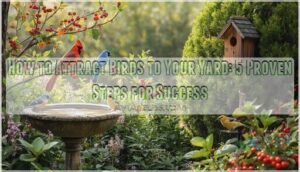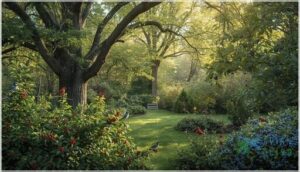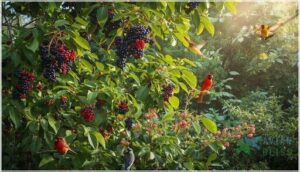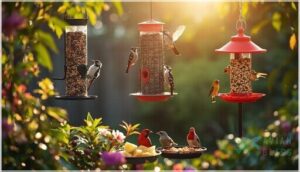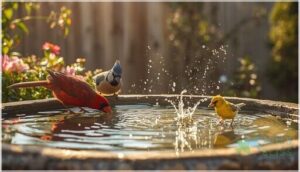This site is supported by our readers. We may earn a commission, at no cost to you, if you purchase through links.
Birds won’t visit a yard that doesn’t meet their basic needs. They require food, water, shelter, and safe nesting spots to thrive in any habitat. Your property can become a haven for local species when you understand what attracts them and how to provide those essentials.
Native plants form the foundation of this approach because they offer natural food sources and familiar shelter that birds recognize and trust. Creating the right conditions means combining fruiting trees, seed-bearing flowers, and dense shrubs with reliable water sources and protected nesting areas. These five proven steps transform ordinary yards into thriving bird habitats that support diverse species throughout the year.
Table Of Contents
- Key Takeaways
- Choose Native Plants for Bird Attraction
- Provide Diverse Food Sources
- Supply Fresh Water Year-Round
- Create Safe Shelter and Nesting Areas
- Maintain a Bird-Friendly and Safe Yard
- Frequently Asked Questions (FAQs)
- How do I attract birds to my garden?
- How to attract birds to your backyard?
- How do you keep a bird in a garden?
- How do I attract songbirds to my garden?
- What attracts birds the most?
- Why won’t birds come to my yard?
- What smells attract birds?
- What food attracts birds the most?
- How do I attract birds to my yard?
- How do I Make my Yard a bird-friendly habitat?
- Conclusion
Key Takeaways
- Native plants like oaks, serviceberries, and dense shrubs provide birds with natural food, shelter, and nesting sites they trust.
- Offering a mix of feeders with varied seeds, suet, nectar, and fresh fruit attracts a wide range of bird species throughout the year.
- Clean, shallow bird baths and moving water features ensure birds have safe, reliable drinking and bathing spots in every season.
- Avoiding pesticides, maintaining feeder and bath cleanliness, and placing shelters near cover keep visiting birds healthy and protected.
Choose Native Plants for Bird Attraction
Native plants are the foundation of a bird-friendly yard because they provide the natural food sources and shelter that local species have relied on for generations.
These plants produce the fruits, seeds, nectar, and insects that support birds during migration, nesting season, and harsh winter months.
By choosing the right combination of trees, shrubs, and flowers, you’ll create a habitat that attracts a wider variety of birds throughout the year.
Best Native Trees and Shrubs for Birds
Fruiting trees like oaks, serviceberries, and dogwoods form the backbone of a thriving bird habitat. You’ll want to layer in shrubs such as winterberry holly and highbush blueberry to create vertical diversity.
Native planting works best when you combine tall tree species with dense hedges, giving birds year-round food and shelter. Choose varieties suited to your region’s soil and climate for reliable garden design results.
By considering the importance of methodological rigor in scientific studies, you can better understand the value of native plants in supporting local ecosystems.
Selecting Seed-Bearing Flowers
Seedheads on native perennials give finches, sparrows, and other small birds a reliable food supply beyond what you’ll put in feeders. For best results: You can also supplement their diet with quality finch seed blends that offer the small seeds these birds prefer year-round.
- Choose coneflowers, black-eyed Susans, and native sunflower seeds over sterile hybrids
- Plant drought-tolerant varieties that hold seed production through fall migration
- Let spent blooms stand rather than deadheading
Native blooms attract more species than commercial bird seed blends alone. Pairing native plants with a heated bird bath ensures visiting species have both food and water throughout winter months.
Incorporating Fruiting Plants
Beyond seed-producing plants, you’ll want fruiting trees and berry bushes to round out your yard. Native serviceberry, elderberry, and dogwood varieties provide fruit that ripens at different times throughout the year. Place fruiting shrubs near protective cover so birds can feed safely. This diversity keeps backyard birds coming back when birdseed runs low and natural seed production slows in late summer. Pair your fruiting plants with a clean, well-maintained bird bath to give visiting species a reliable water source during hot months when natural options dry up.
| Fruit Type | Best Native Plant Choices | Peak Fruiting Season |
|---|---|---|
| Berries | Elderberry, chokeberry, winterberry | Summer through fall |
| Drupes | Serviceberry, dogwood, wild cherry | Spring through summer |
| Pomes | Hawthorn, crabapple varieties | Late summer into winter |
| Multi-season | Viburnum species, holly cultivars | Fall through early spring |
Provide Diverse Food Sources
Offering an array of food options is one of the best ways to attract a variety of bird species to your yard. Different birds have different dietary needs, so providing multiple food sources encourages greater diversity and keeps your feathered visitors well-fed throughout the year.
Here are three essential feeding strategies to bring cardinals, woodpeckers, hummingbirds, and many other species to your backyard.
Types of Bird Feeders and Seed
You’ll find seed feeder options that match specific bird preferences and behaviors. Platform feeders work well for ground-loving sparrows and doves, while tube feeders with capped ports keep larger species from dominating the birdseed supply. Pair your feeders with a well-maintained bird bath to create a complete backyard habitat that attracts diverse species throughout the seasons.
Black oil sunflower seeds attract the widest variety of visitors, but nyjer feeders with tiny ports target finches specifically.
Space your bird feeders 10–15 feet from cover to reduce predation risk.
Offering Suet, Nectar, and Fruit
Suet varieties with added seeds or dried fruit deliver high-energy calories that attract woodpeckers and nuthatches, especially during winter months.
Nectar feeders using a 4:1 water-to-sugar ratio bring hummingbirds into your backyard, while fresh fruit offerings appeal to thrushes and waxwings.
Position suet feeders on sturdy hooks away from branches, and place nectar feeders at least 5 feet high with clear approach paths for ideal bird nutrition.
Seasonal Feeding Tips
You’ll want to shift your feeding strategy as seasons change to support birds through their toughest times. During cold weather, high energy suet feeders and calorie-dense bird seed help birds survive winter feeding challenges, while protein-rich options support molt nutrition in late summer.
Keep fresh water available year-round, and position bird feeders near shelter for attracting birds to your backyard safely.
Supply Fresh Water Year-Round
Water is just as essential as food for attracting birds to your yard. A reliable water source gives birds a place to drink and bathe, which keeps their feathers in good condition for flight and insulation.
Here are three effective ways to provide fresh water that will draw more species to your space throughout the year.
Choosing and Placing Bird Baths
A well-chosen bird bath can transform your yard into a bustling avian oasis. When selecting water features, consider these essentials:
- Opt for shallow water sources with 1 to 2 inches depth to accommodate most songbirds safely
- Choose durable bird bath materials like concrete or heavy plastic that withstand weather extremes
- Position baths 4 to 5 feet high near shrubs for quick predator deterrents
- Place multiple water sources throughout your space to reduce competition
Maintaining Clean Water Sources
You can’t invite birds to your yard and then serve them stale water—it’s a recipe for disease. Replace water in your bird bath every two days, especially in hot weather, to prevent pathogen buildup.
Stale water invites disease—refresh your bird bath every two days to keep feathered visitors healthy
Clean water sources weekly with mild soap and rinse thoroughly. Position birdbaths in shaded spots to slow evaporation and keep water fresh longer for proper bird hydration.
Adding Moving Water Features
Birds can’t resist the sound of splashing water—it’s like ringing a dinner bell. A small fountain or dripper transforms your bird bath into a magnet for species like sparrows and robins.
Solar pumps keep water moving year-round without hiking up your electric bill, while reducing algae growth.
Position your water feature near shelter and feeders so birds feel safe while they sip and splash.
Create Safe Shelter and Nesting Areas
Birds need more than food and water to stick around—they’re looking for safe places to rest, hide from predators, and raise their young. Your yard can become that refuge if you provide the right kinds of cover and nesting spots.
Here are three practical ways to create shelter that birds will actually use.
Planting Dense Shrubs and Evergreens
Think of dense shrubs and evergreens as your yard’s security blanket for backyard birds. Shrub layering at three to eight feet creates the multi-tiered structure birds need for concealment.
Plant native species in clumps of three to five rather than singles—this dense planting mimics natural growth patterns.
Evergreen selection matters too: choose both needle-leaf and broadleaf varieties to provide year-round shelter while supporting garden wildlife throughout every season.
Installing Birdhouses and Nest Boxes
Beyond planting, you can offer purpose-built shelter through birdhouse designs and nesting boxes customized to backyard birds.
Nest box placement at six to twelve feet, with entrance hole sizes matching target species (1 1/8 to 1 1/4 inches for songbirds), encourages occupancy.
Mounting techniques should include predator guards on poles or trees, while morning sun exposure helps create a bird-friendly habitat that fosters successful nesting.
Leaving Brush Piles and Deadwood
While birdhouses provide nest sites, you can also leave brush piles and deadwood in quiet corners for natural shelters. These structures support wildlife habitat and ecosystem balance by hosting insects that birds eat.
Stack branches loosely to create air pockets, positioning piles near shrubs for added cover. This simple brush management step enhances wildlife conservation and birdfriendly habitat creation without extra cost.
Maintain a Bird-Friendly and Safe Yard
Getting birds to visit your yard is only half the battle—keeping them healthy and safe takes ongoing effort. A few simple maintenance habits can prevent disease, protect birds from accidents, and guarantee they keep coming back.
Here’s how to maintain a yard that aids your feathered visitors throughout the year.
Avoiding Pesticides and Chemicals
You can protect visiting birds by choosing organic pest control over chemical treatments. Native, pesticide-free landscaping fosters ecological balance and biodiversity while encouraging sustainable wildlife conservation.
Try integrated pest management—targeting specific pests with minimal impact—or mechanical removal methods. Non-toxic methods and eco-friendly practices keep your yard chemical-free, letting birds forage safely.
Chemical-free gardening strengthens environmental sustainability while creating healthier habitats for feathered visitors.
Regular Cleaning of Feeders and Baths
Once you’ve eliminated chemicals, you’ll want to maintain feeder sanitation and bath maintenance through consistent cleaning schedules.
Wash bird feeders and bird baths at least every two weeks—weekly in hot weather—using mild dish soap and warm water. This equipment care prevents disease transmission between visitors.
Replace water every 2–3 days to guarantee water quality, keeping your bird boxes and feeding stations safe.
Placing Feeders and Baths Safely
Where you position your bird feeders and birdbath matters just as much as keeping them clean. Smart feeder placement protects your avian visitors from hazards while giving you better viewing opportunities.
- Hang tube feeders 5–6 feet high to reduce predator control risks
- Keep bird baths at least 10 feet from windows to prevent window collisions
- Check feeder maintenance weekly for damaged parts or spillage issues
Frequently Asked Questions (FAQs)
How do I attract birds to my garden?
You can turn your space into a haven for urban wildlife conservation by combining three essentials: native plants that support bird migration patterns, fresh water in a bird bath, and diverse bird feeders positioned strategically.
This approach aids overall bird conservation efforts and helps attract various bird species.
How to attract birds to your backyard?
Attracting birds to your garden starts with native plantings and diverse food sources.
Install bird feeders with varied seed types, offer fresh water year-round, and create shelter through dense shrubs—essential for successful backyard habitat design.
How do you keep a bird in a garden?
Keep birds around by maintaining consistent food, clean water, and safe shelter. Dense shrubs, properly placed birdhouses, and avoiding pesticides support bird behavior and habitat stability—core birdscaping tips and techniques for a birdfriendly garden.
How do I attract songbirds to my garden?
Picture a warbler pausing mid-migration in your garden. Attracting songbirds means planting native trees and shrubs, offering varied food sources, and maintaining fresh water—key elements of creating a bird-friendly yard.
What attracts birds the most?
Birds respond most strongly to abundant food variety, fresh water quality, and dense native plants that mirror natural habitat.
Multiple feeders, seed-producing plants, and strategically placed birdhouses improve garden layout for successful bird watching.
Why won’t birds come to my yard?
If your yard lacks bird-friendly habitat elements—varied food sources, clean water, or safe shelter—you won’t see many visitors.
Noise pollution, predators, and unsuitable plant choices also discourage backyard bird watching success.
What smells attract birds?
Native flowering plants emit subtle aromas that support bird habitat creation.
Fragrant flowers and aromatic herbs attract insectivorous bird species indirectly by drawing insects.
Scented shrubs with floral scents work best alongside food and water sources.
What food attracts birds the most?
Black oil sunflower seed attracts the widest variety of songbirds, while suet offerings draw woodpeckers and nuthatches.
Nectar feeders bring hummingbirds, and fruit sources appeal to orioles and waxwings during migration.
How do I attract birds to my yard?
Picture feathered visitors landing in your garden throughout the seasons. You’ll need native plants, multiple feeders, fresh water, shelter, and eco-friendly yard planning to create a bird-friendly habitat that fosters wildlife conservation and backyard gardening for birds.
How do I Make my Yard a bird-friendly habitat?
You’ll support bird migration and wildlife conservation by blending native plants, clean water sources, and chemical-free garden design into your sustainable landscaping—creating ecosystems where local and visiting species thrive naturally.
Conclusion
A single chickadee visits first, testing your offerings. Within weeks, that cautious scout brings friends—then cardinals, goldfinches, and jays follow. Your yard becomes their destination because you’ve built trust through consistent care.
Learning how to attract birds to your yard means creating a space where they feel genuinely safe and supported. Watch feeders at dawn, listen for new songs at dusk, and remember that every small effort compounds into something extraordinary for both you and your feathered neighbors.

